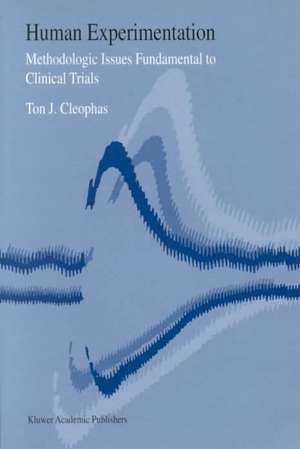Human Experimentation: Methodologic issues fundamental to clinical trials
Autor Ton J. Cleophasen Limba Engleză Paperback – 31 iul 1999
Preț: 359.05 lei
Preț vechi: 377.95 lei
-5% Nou
Puncte Express: 539
Preț estimativ în valută:
68.70€ • 71.73$ • 56.86£
68.70€ • 71.73$ • 56.86£
Carte tipărită la comandă
Livrare economică 04-18 aprilie
Preluare comenzi: 021 569.72.76
Specificații
ISBN-13: 9780792358275
ISBN-10: 0792358279
Pagini: 120
Ilustrații: 120 p.
Dimensiuni: 160 x 240 x 6 mm
Greutate: 0.18 kg
Ediția:1999
Editura: SPRINGER NETHERLANDS
Colecția Springer
Locul publicării:Dordrecht, Netherlands
ISBN-10: 0792358279
Pagini: 120
Ilustrații: 120 p.
Dimensiuni: 160 x 240 x 6 mm
Greutate: 0.18 kg
Ediția:1999
Editura: SPRINGER NETHERLANDS
Colecția Springer
Locul publicării:Dordrecht, Netherlands
Public țintă
ResearchCuprins
1 Placebos.- 1.1 Introduction.- 1.2 Ethical problems with placebo-controlled trials.- 1.3 Benefits of placebo-controlled trials.- 1.4 Technical problems with placebo-controlled trials.- 1.5 Conclusions.- 2 Fundamental Issues of Choosing the Right Type of Trials.- 2.1 Introduction.- 2.2 Ethical problems.- 2.3 Costs.- 2.4 Sample size.- 2.5 Between-subject variability of symptoms.- 2.6 Physical carryover effects.- 2.7 Time effects.- 2.8 Correlation between treatment modalities.- 2.9 Conclusions and examples.- 3 Lack of Real Science of Symptom-Based Care.- 3.1 Introduction.- 3.2 Methods.- 3.3 Study selection and data extraction.- 3.4 Data synthesis.- 3.5 Discussion.- 4 Carryover Effects in Clinical Research.- 4.1 Introduction.- 4.2 Dose response and dose titration studies.- 4.3 Studies with duplicate standard deviations.- 4.4 Open evaluations studies.- 4.5 Cross-over studies.- 4.6 Self-controlled Studies.- 4.7 Parallel-group studies.- 4.8 Studies with subjective variables.- 4.9 Discussion.- 5 Criticism of Negative Studies due to Negative Correlations.- 5.1 Introduction.- 5.2 Levels of correlation and sensitivity of testing.- 5.3 A simple test to check a posteriori whether the cause of a negative result is its level of correlation.- 5.4 Review of published crossover studies with a presumably negative correlation.- 5.5 Review of published crossover studies with a presumably positive correlation.- 5.6 Conclusions and recommendations.- 5.7 Conclusions.- 6 Between-Group Disparities in Drug Response.- 6.1 Introduction.- 6.2 Statistical model.- 6.3 Hypothetical examples, power analysis.- 6.4 Discussion.- 7 Specific Problems with Trials of Chronic Diseases.- 7.1 Introduction.- 7.2 Published clinical trials.- 7.3 Strengths and weaknesses of the two designs.- 7.4 Stage of study and the type of trial.- 7.5 More recent statistical papers on the subject.- 7.6 Conclusions.- 8 Clinical Trials with New Endpoints.- 8.1 Introduction.- 8.2 Subjective endpoints.- 8.3 New ethical priorities.- 8.4 Human touch rather than scientific rigor.- 8.5 Little emphasis on informed consent.- 8.6 Self-controlled rather than parallel-group designs.- 8.7 Conclusions.- 9 Linear Scale Assessment of Relevant Domains of Quality of Life - an example.- 9.1 Introduction.- 9.2 Patients and methods.- 9.3 Results.- 9.4 Discussion.- 10 Item Response Modeling and Quality of Life.- 10.1 Introduction.- 10.2 Methods.- 10.3 Results.- 10.4 Discussion.- 11 Is Selective Reporting of Well-Designed Research Unethical as Well as Unscientific ?.- 11.1 Introduction.- 11.2 Arguments against reporting “negative” studies.- 11.3 Arguments in favor of reporting “negative” studies.- 11.4 How progress of science was made in the past.- 11.5 Today the progress of science is faster, new rules are required.- 11.6 Suggestions for a balanced approach to the problem of selective reporting.- 11.7 Conclusions.- 12 Informed Consent Under Scrutiny, Suggestions for Improvement.- 12.1 Introduction.- 12.2 Ethical difficulties with the informed consent principle.- 12.3 Ethical difficulties with the informed consent process.- 12.4 Example of a flawed consent information form of a double-blind parallel-group study.- 12.5 Suggestions for improvement of the informed consent procedure.- 12.6 Conclusion.












